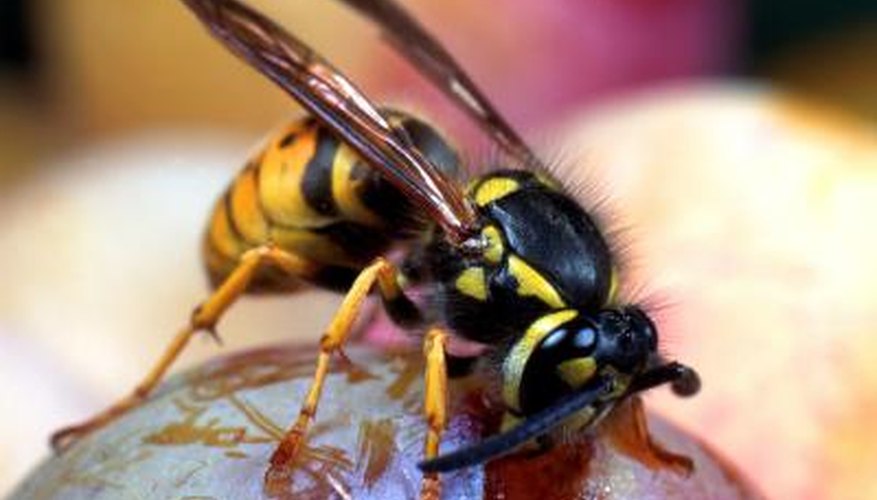Wasps are not the most welcome of houseguests. They swarm, sting, buzz and generally intimidate. Wasp swarms appear around the home and in the garden for a number of reasons. Identifying and managing the factors bringing wasps to your home helps control the proliferation of the insects, though gardeners should be wary of the many negative consequences of ridding your garden of its wasp population.
Habitat
Two types of wasps appear around the house, social wasps and solitary wasps. Social wasps live in large colonies of dozens or even hundreds of insects while solitary wasps live in individual habitats. Yellowjackets, a common social wasp species, live in hollows in the ground or near the ground. They often live underneath homes or in hollows in the foundations of buildings. Hornets, meanwhile, build nests in trees and may be around your house if your yard has trees. Solitary wasps like mud daubers and cicada killers build habitats in eaves of buildings or in the dirt of gardens, making them a common presence around houses.
- Two types of wasps appear around the house, social wasps and solitary wasps.
- Solitary wasps like mud daubers and cicada killers build habitats in eaves of buildings or in the dirt of gardens, making them a common presence around houses.
Food
The abundance of food in a particular region encourages wasps to build nests in that area. As the name implies, cicada killer wasps kill cicadas. They then lay eggs in the cicadas and bury them in holes in the ground. An abundance of cicadas draws cicada killers to an area. Social and solitary wasps subsist on other insects, such as aphids, flies, caterpillars and Japanese beetles. They also forage in garbage or compost heaps for fruit and meat. If you keep exposed or easily accessible fruit or meat outside of the home or have a number of pest insects in the garden, you'll likely find wasps around your house. Wasps also exhibit attraction to fragrant flowers.
- The abundance of food in a particular region encourages wasps to build nests in that area.
- If you keep exposed or easily accessible fruit or meat outside of the home or have a number of pest insects in the garden, you'll likely find wasps around your house.
Identifying Wasps
Yellowjackets build nests in secluded environments. These nests prove rarely, if ever, exposed. The easiest way to identify yellowjackets is their behaviour. Wasps spotted frequently coming and going from cracks or hollows in or very near the ground are most likely yellowjackets. Hornets build large papery nests high up in trees. These nests resemble enormous pine cones. Solitary wasps often live in mud flutes, or tubes. These wasps commonly build at least two or three such flutes, one for living in and others for storing food in. Large wasps with extended bodies found buzzing close to the ground are either daubers or cicada killers.
- Yellowjackets build nests in secluded environments.
- Large wasps with extended bodies found buzzing close to the ground are either daubers or cicada killers.
Wasp Management
Expert resources classify wasps as beneficial insects because they minimise pest insect populations, pollinate numerous flower species and only sting humans when provoked or panicked. However, those with allergies to wasp venom should not manage wasp populations for personal safety.
Management techniques include destroying nests and creating inhospitable nesting environments by spreading pesticides and filling hollows and cracks with debris, cement, caulk or another material. Always consult an expert before using pesticides, as they may kill beneficial species such as ladybirds while being ineffective on damaging pests like aphids.
- Expert resources classify wasps as beneficial insects because they minimise pest insect populations, pollinate numerous flower species and only sting humans when provoked or panicked.
- Always consult an expert before using pesticides, as they may kill beneficial species such as ladybirds while being ineffective on damaging pests like aphids.
Removing food sources such as pest insects, cicadas, garbage, or fruit fallen from fruit trees encourages wasps to seek greener pastures.
